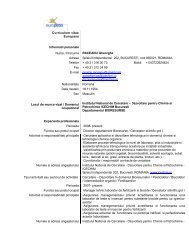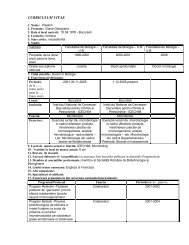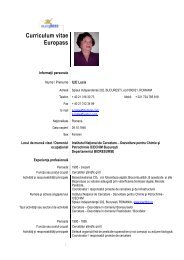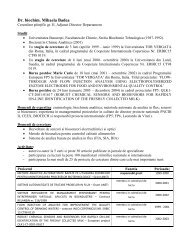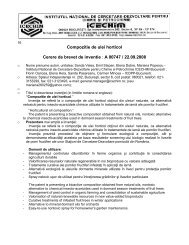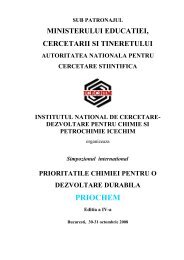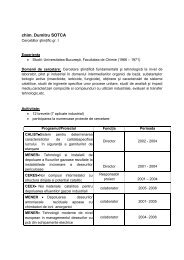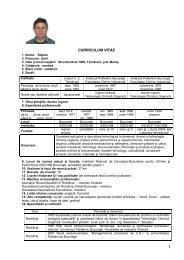INSTITUTUL NAÅ¢IONAL DE CERCETARE-DEZVOLTARE - ICECHIM
INSTITUTUL NAÅ¢IONAL DE CERCETARE-DEZVOLTARE - ICECHIM
INSTITUTUL NAÅ¢IONAL DE CERCETARE-DEZVOLTARE - ICECHIM
- No tags were found...
You also want an ePaper? Increase the reach of your titles
YUMPU automatically turns print PDFs into web optimized ePapers that Google loves.
1 Bioresources and biomaterials - OBIOETHANOL PRODUCTION FROM MOLASSES BY IMMOBILIZEDSACCHAROMYCES CEREVISIASECălinescu Ioan 1 , Trifan Adrian 1 , Dima Romulus 1 , Teiu Corina 1 , Chipurici Petre 1 ,Alexandrescu Elvira 21 Politehnica University of Bucharest, Faculty of Applied Chemistry and Material Science,149 Calea Victoriei, Bucharest, 010072, Romania2 Romanian Research and Development Institute for Gas Turbines, COMOTI, 220D IuliuManiu, Bucharest, 061126, RomaniaFirst generation bioethanol is the leader biofuel produced in the world. It is producedby fermentation of sugars derived from starch or other sugar feedstocks. The development ofcontinuous fermentation process enables automation of the production installation withsignificant operation cost reduction. The yeast should be immobilized on a support if thecontinuous fermentation process is carried out in a plug-flow reactor. This study investigatesthe performance of Saccharomyces cerevisae yeast immobilized on two types of polymericsupports (polyacrylamide and calcium alginate) for the production of bioethanol from beetmolasses. The activity of the immobilized yeast is analyzed also in comparison to the freeyeast in suspension. The influences of the type of support and of fermentation conditions overthe parameters for obtaining ethanol are underlined in this work.The immobilized yeast was tested in a batch reactor for the fermentation of somemolasses solutions. The fermentation rates and the yield of the process were examined todescribe the consumption of sugars and the production of ethanol. Bioethanol concentration inthe fermentation mixture was determined by gas chromatographic analyses. The sugars typeand concentration were determined by HPLC analyses. The effect of different concentrationsof molasses on the production of ethanol was evaluated. The inner and the outer surfaces ofthe fresh and immobilized beads of yeast cells were scrutinized by means of scanningelectronic microscopy. The immobilization of yeast on polyacrylamide gel or calcium alginateproceeds with high ethanol production. The advantage of using immobilized yeast onpolyacrylamide gel is that the granules are more resistant, and they keep their shape duringthe fermentation process.Acknowledgments: The work has been funded by the Sectoral Operational ProgrammeHuman Resources Development 2007-2013 of the Romanian Ministry of Labour, Family andSocial Protection through the Financial Agreement POSDRU/89/1.5/S/52432.




